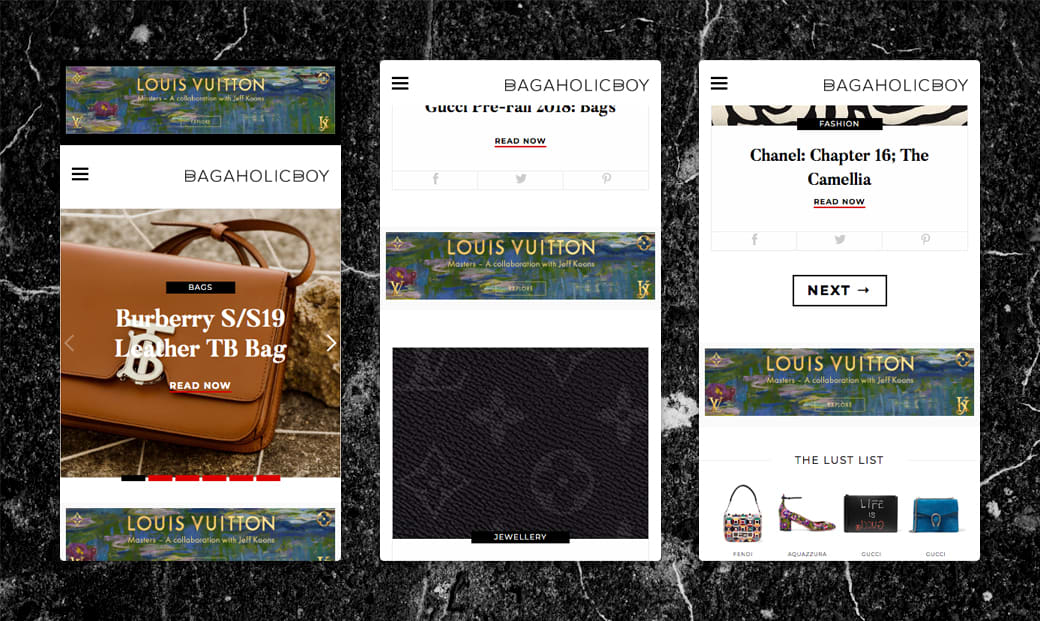
Bagaholicboy
The common belief about modern media is that the publishing industry is dying. Rapidly decreasing ad rates are influencing the direction and imagination of the industry itself; rather than producing the best experience and journalism, digital publications are rushing to generate revenue as fast as possible.
This mindset has somewhat led to the design and content conventions shaping present-day publishing: low-quality listicles and predatory posts authored to acquire the maximum random audience about trending topics, blasted endlessly on all social channels.

Bagaholicboy began as a humble blog more than a decade ago and has kept to its core personality: a boy who loves buying and writing about luxury bags. Over the years the blog has grown beyond just bags and into a formidable publishing platform for curated luxury products.
To change the look of a digital publication, first change the approach
By convention, the world of digital media and by extension, digital publishing, was founded by design principles that applied to desktop computers. Over the years, as content became more accessible on mobile devices, audiences have since changed their media consumption habits. One of the observations we made during our audit was that Bagaholicboy saw nearly 80% of its users consuming its content from a mobile device, yet the site was still skewed to serve traditional desktop audiences.

We found that the site was primarily built around blog-like structures, where each new story was told through a fixed post structure. We postulated that some stories need not be told as part of an article to be effective: like Bagaholicboy’s current items of desire. These insights helped shape the design of new components for the site that do not conform to a typical post archetype.
As we restructured and redesigned the site, each component was reconsidered from the ground up to cater to the dominant mobile audience. At the same time, the interface was enhanced to be adaptive to cater to a range of screen sizes from small tablets to large desktop monitors.
Approaching the site with new components and formats also meant new opportunities for collaboration and fresh revenue streams. Brand partners were more open to invest in content-centric snapshots of information as opposed to more conventional ad units.
Reclassifying the brand
While the site’s name implied that it focused exclusively on bags, we needed to expand its inclusions. Working with the Bagaholicboy team, we decided on five key pillars that would dictate the classification of content. We then skewed the component structure of articles to prominently associate posts with one of these five pillars. This elevated the site from having a single stream of content, into a site with a clear set of verticals.

Quintupling advertising opportunity
Building upon our plan for differentiating each of the five verticals, we customized an administration panel for the Bagaholicboy team to easily manage category and contextually aware ads. This meant that brands and partners could technically collaborate with Bagaholicboy on specific verticals (e.g. a luxury timepiece brand may only want to target the ‘watches’ category and all posts associated within it), ultimately allowing the platform to cater to more prudent advertising budgets and more targeted ad spending.
This quintupling of advertising opportunity also allowed Bagaholicboy to sell more content spaces to more media partners.

Quickly sampling and scanning through articles is a common and fundamental aspect of some of the most popular apps like Instagram. The strategy and structure of Bagaholicboy borrows those conventions to create a natively familiar and relevant digital experience. In this sense, the new structure is not inventive as much as it is resourceful; it answers the question of what scrolling through a mobile app might look like if we replaced profile pictures and memes with curated luxury content.
Reimagining advertising
One of the nice things about working with a client that is willing to take calculated risks is that we were able to propose the adoption of a rare ad unit size. The goal was to have a format and size that was less intrusive, yet highly engaging by looking as little ad-like as possible, while still adhering to the prevailing Interactive Advertising Bureau (IAB) standards.

Because Bagaholicboy offered what is known in the industry as a 100% share of voice (or SOV), it was critical to ensure we did not bombard the users with advertising when planning the placements for ad units. We were careful not to propose a layout that might lead to an alienating or negative experience for users and ultimately killing the platform’s loyal readership.